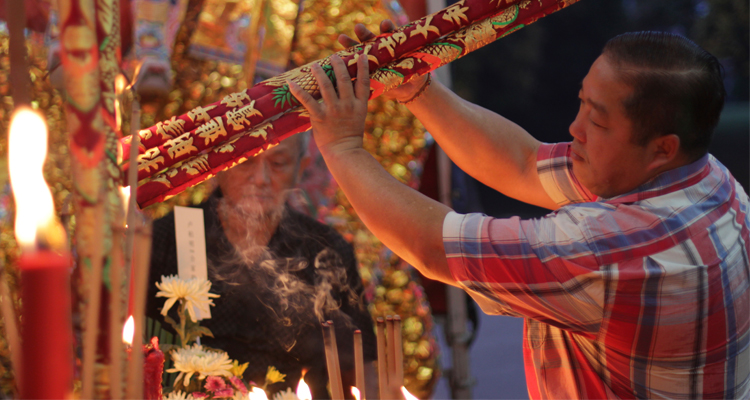The Halloween night we know and love is based on traditions dating back thousands of years. Apparently, it originated in Ireland, where, it is said, at harvest time the spirits of the dead would return to visit or haunt the living. (Leading us, for instance, to dress up like ghosts and decorate lawns like cemeteries!)
But did you know there are many Halloween-like traditions around the world?*
- “The Hungry Ghost Festival” (Yu Lan) is celebrated in many parts of Asia, including Hong Kong, Thailand, and Malaysia. The custom varies, but generally it’s believed that the spirits of the dead roam the world for a day and a night. People light fires and put out food and gifts to either comfort the spirits or satisfy angry ghosts. (The photo above pictures a man burning an incense stick during this festival in Malaysia.)
- In Czechoslovakia, on Halloween night, chairs are placed by the fireside: one chair for each of the living, and one for each family member’s spirit.
- In Austria, they put out bread, water, and a lamp before going to bed on Halloween. This is meant to welcome dead souls back to Earth.
- In Japan, they celebrate the “Obon Festival” (pronounced, “oh bone”) which is dedicated to the spirits of ancestors. They prepare foods and light candle lanterns that are set afloat on rivers. During the festival, a fire is lit every night to show the spirits the way to their families.
- In Germany, people hide their knives on Halloween. They don’t want returning spirits to find them!
- If you visited France 20 years ago on October 31, you would have seen little signs of Halloween. There just wasn’t a folk tradition honoring (or fearing) spirits who return to the land of the living. Yet today, it’s celebrated pretty widely. Why? Mass media, American influences, and the fact that people love to party have all popularized the holiday. So today, many French dress in scary costumes, carve jack-o’-lanterns, go from house to house or store to store for candies—but, often, have no clear idea what Halloween is really about! Will it last, or is it just a fad? Time will tell.
- In China, there’s a Halloween-type festival with Buddhist heritage called Teng Chieh. In Buddhist temples, people create large paper boats which are burned. The purpose of this is to remember the dead, but also to free the spirits of the “pretas.” Pretas are the spirits of those who died but were never buried. People believe their presence is dangerous.
Really Big Halloween Festivals: Start with Mexico/Latin America
Our Latin American neighbors have a three-day Halloween festival, “El Dia de los Muertos:” the “days of the dead” beginning October 31.
- The tradition goes back to the early history of the native Aztecs. It’s designed to honor the dead who are believed to return at this time of the year.
- Candles are burned to help the departed find their home. Families create an altar and decorate it with the deceased’s favorite foods and drinks.
- On November 2, relatives gather at graves to picnic and share stories of the departed.
- At this same time, Monarch butterflies migrate to Mexico’s oyamel fir trees. The Aztecs believed that these butterflies carried the spirits of dead ancestors.
- In the villages, parades are held in which people dress as skeletons and dance in the streets. Often, a live person is put inside a coffin which is paraded through the streets while fruit, flowers, and candies are thrown into the casket. The festival is essentially about life from its beginning to its end.
And now, where our Halloween started: Ireland
An American kid in Ireland on Halloween night would feel right at home, with children dressed up in costumes, going “trick-or-treating.” They even bob for apples! But there are unique traditions, too:
- In rural areas, bonfires light up the sky as they have for centuries.
- After trick-or-treating, most people attend parties and games are played. Parents often set up treasure hunts for candy. There’s also an Irish card game in which a child chooses a card and receives the prize under it (could be a coin or more candy).
- A traditional Halloween dessert is barnbrack, a kind of fruitcake. A “magical” treat is baked inside the cake that can foretell the future. If a ring is found, it means the person will soon be wed; a piece of straw predicts a prosperous year.
- Children are also known to play tricks, such as “knock-a-dolly,” in which children knock on the doors of their neighbors, but run away before the door is opened.
Does your family have any unique Halloween traditions? Share them in the comments section below!
*This article was adapted from the Pumpkin Patches and More website where you’ll find more details.





































